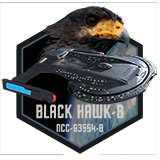Overview
Every bridge contains a Mission Operations station. This station provides additional support to the Chief Operations Officer, and is specifically responsible for monitoring activity relating to secondary missions. In doing so, Mission Operations acts as an assistant to the Chief Operations Officer, relieving her/him of responsibility for lower-priority tasks that must be monitored by a human operator.
Mission Operations is responsible for assignment of resources and priorities according to guidelines specified by the Chief Operations Officer and by operating protocols. For example Operations may determine that a particular research project is to have usage of specific elements, subject to priority usage of those same sensors by the bridge. Although the actual minute-to-minute assignment of resources will be automatically handled by the Operations panel software. Mission Operations will monitor the computer activity to ensure that such computer control does not unduly compromise any mission priorities. This is particularly important during unforeseen situations that may not fall within the parameters of preprogrammed decision-making software.
Mission Operations is responsible for resolving low-level conflicts, but will refer primary mission conflicts to the Chief Operations Officer.
The Operations officer assigned to this service generally serves as relief Chief Operations Officer when the duty Operations officer is away from station.
Other Bridge Station Duties
This station is responsible for monitoring telemetry from primary Away Teams. This includes tricorder data and any other mission-specific instrumentation.
Mission Operations is also responsible for monitoring the activities of secondary missions to anticipate requirements and possible conflicts. In cases where such conflicts impact on primary missions in progress, Mission Operations is required to notify the Chief Operations Officer.
During Alert and crisis situations, Mission Operations also assists the Tactical Officer, providing information on Away Teams and secondary mission operations, with emphasis on possible impact on security concerns.
Traffic Control
Coordinating Shuttlebay & Flight Deck
Coordinating the shuttle bay and flight deck is a process that puts the Operations officer and the FCO working together to make sure things are handled properly. While the FCO is responsible for shuttles the Operations officer is responsible for communicating with incoming and outgoing shuttles and fighters to make sure there are no accidents.
Starship Docking Protocol
The Operations officer is responsible for communicating with base operations and relaying that information to the FCO when the ship is docking or leaving. During this time they are also responsible for relaying the information to the engineering department for switching power accordingly.
Procurement
Obtaining Materials
Every Starbase and station has a supply depot. Plus there are supply runs continuously throughout the quadrant. Anything that is Starfleet issued and not replicatable can be obtained from these supply depots and supply Operations.
One other Starfleet resource is other ships. Many times extra parts can be found on a sister ship. Every Operations officer should be aware of who is in the area and where they are. Disasters can often be prevented by the quick procurement of parts.
Obtaining Resources
There are many items that are required for a ship or station due to the diverse amount of species. Although many of these items can be found in Starfleet stores…personal icons, exotic foods and even some custom furniture may need to be gotten from elsewhere. There are several resources available: Civilian Operations along the promenades of most stations and starbases. Even on various planets. But the biggest resource is the independent trader.
A good Operations will build a network of traders with their territory. Although latinum is the currency most used in the quadrant….there is a large bartering system in place. Older Operations often mentor newer Operations in the ways and means of bartering, although Starfleet ‘unofficially’ looks for those qualities in their Operations candidates.
One thing that a good Operations officer must be aware of is the different bartering systems in different areas. What may be valuable in one sector may be common place in another. Operations officers are in constant communication with each other so that these things may be shared.
| OPERATIONS DEPARTMENT | |
| IMPORTANT ERRATA | Operations Department • Operations Positions • Access Codes • Bio-neural circuitry • Communications • Computer Access Levels • Duty Roster • LCARS Administration • Mission Operations • ODN Network • Operating Modes • Personnel Allocation • Resource Allocation • Transportation • Ship Specifications |
| NOTABLE LOCATIONS | Chief Operations Officer's Office • Computer Core • Main Engineering • Auxiliary Control |
| PERSONNEL FUNCTIONS | Alert Status • Cabin Assignments • Computer Access Levels • Deck Listing • Department Head • Duty Roster • Operating Modes • Security Clearances • Rank Guide • Rank Comparisons • Uniforms |
| DEPARTMENTS | Command • Flight Control • Intelligence • Operations • Engineering Security/Tactical • Medical • Science • Squadron • Civilians |
